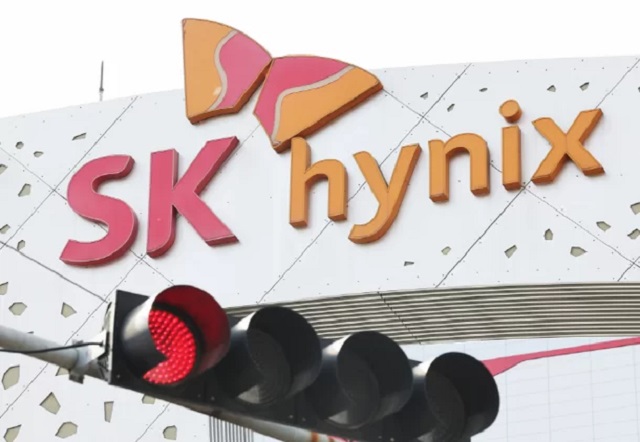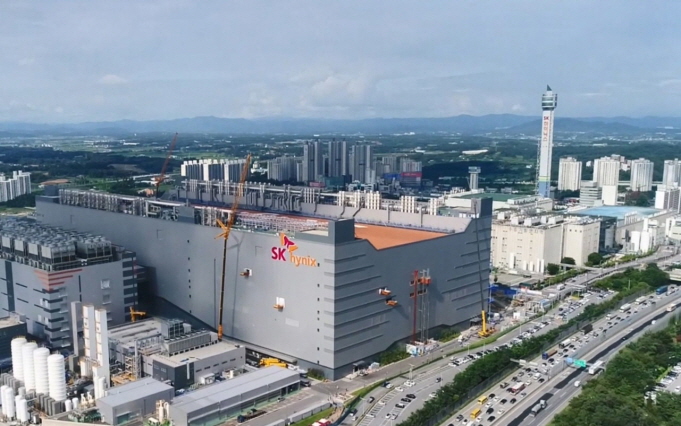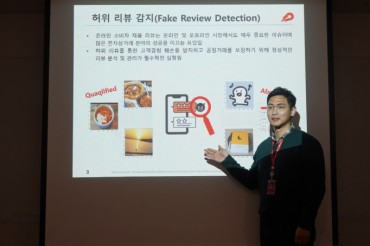
SK hynix Inc.’s logo is seen in this file photo taken at the company’s headquarters in Icheon, some 58 kilometers southeast of Seoul, on April 26, 2023. (Yonhap)
SEOUL, July 26 (Korea Bizwire) — SK hynix Inc. said Wednesday it logged losses for three quarters in a row as a demand slump continued amid macroeconomic woes, but it called the bottom on the chip market.
The world’s second-largest memory chip maker said in a regulatory filing its operating losses amounted to 2.88 trillion won (US$2.25 billion) in the April-June period, compared with a profit of 4.19 trillion won a year ago.
Net losses came to 2.98 trillion won, plunging from a net profit of 2.88 trillion won a year earlier. Sales fell 47.1 percent to 7.3 trillion won.
While weak consumer demand persists, the memory chip market is believed to “have entered a recovery phase after bottoming out in the first quarter,” the company said during an earnings call.
An inventory correction has continued from the first quarter and production cuts in the industry started to have the desired effect in the second quarter, SK hynix added.
To make a quicker turnaround, the chipmaker said it will expand production cuts for NAND flash with higher inventory levels than DRAM.
“An expansion in the generative artificial intelligence market” has “rapidly” pushed up “demand for AI server memory,” the company also said.
“As a result, sales of premium products, such as HBM3 and DDR5, increased, leading to a 44 percent sequential increase in revenue for the second quarter, while the operating loss narrowed by 15 percent.”
The South Korean chipmaker swung to a deficit in the fourth quarter last year for the first time since the third quarter of 2012, as its customers halted new orders to reduce their excessive inventories amid slow consumer demand.
SK hynix makes most of its profits from selling memory chips. But the macroeconomic woes, including the ongoing war between Russia and Ukraine, inflation and rising interest rates, led consumers to tighten their spending on electronics that need such semiconductors.
Major chipmakers have cut production for months now to deal with excessive inventories and prop up sagging prices.
Analysts forecast demand for memory chips to pick up in the second half, helped by 5G and high-performance computing (HPC).
The inventory correction cycle is also expected to come to an end soon.
SK hynix is also pinning its hopes on the growth of the high-performance server market for artificial intelligence (AI) and a wider adoption of high-capacity memory products to drive demand and boost sales.
“Global big tech companies are increasing purchases of artificial intelligence servers, despite concerns about the chip industry’s slowdown,” said Jung Min-gyu, an analyst at SangSangIn Investment & Securities.
“With its technological leadership in the field, SK hynix is well-positioned to take up more than 50 percent of the high-bandwidth memory market, which will help it make a turnaround faster than its competitors.”
While expectations about an AI-led chip boom are abundant, many factors need to come together for SK hynix to improve future earnings, Nam Dae-jong, an analyst at EBEST Investment & Securities, said.
“An increase in consumer demand is essential. Then there should be a subsequent rise in shipments of mainstream products and prices should rise too,” he said for SK hynix to pull that off.
SK hynix said investment for this year, which is about half of the 2022 level, will remain unchanged but said it will continue putting resources into its core premium products, including high-density DDR5 and HBM3, for future growth.
“Having passed the trough in the first quarter, the memory semiconductor market is seen to have entered the recovery phase,” said Kim Woo-hyun, the chipmaker’s vice president and chief financial officer.
“SK hynix will strive to prop up earnings through its technological competitiveness in high-end products.”
SK hynix shares went down 0.35 percent to close at 113,000 won on the Seoul bourse, versus the wider market’s 1.67 loss.
(Yonhap)







